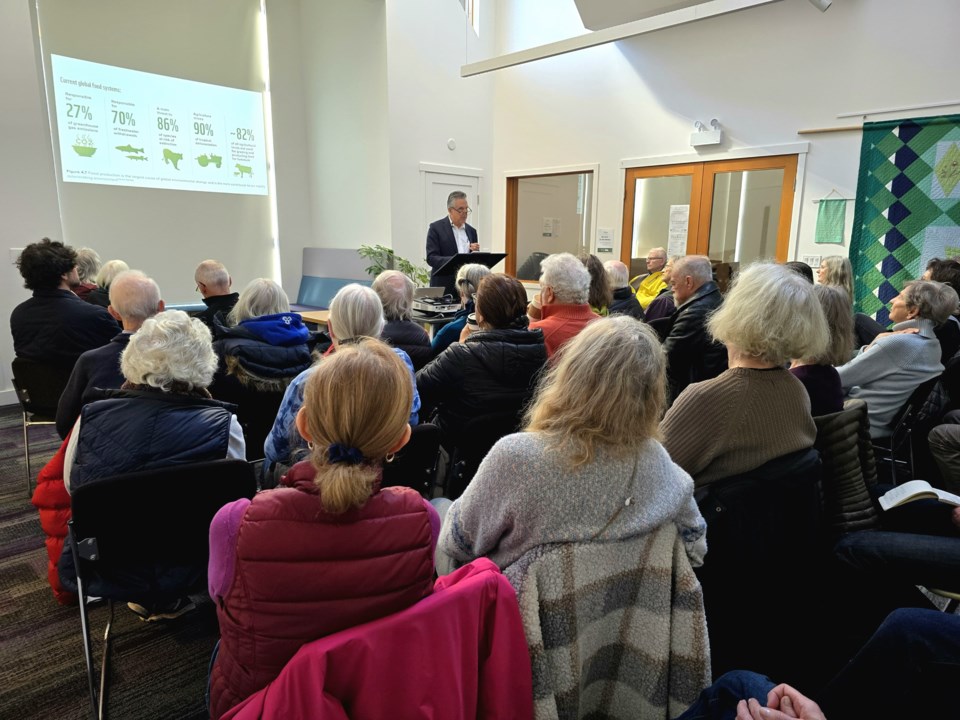Last month we got the very bad news that in 2024 our planet had the hottest year in recorded history – surpassing the 1.5 degree Celsius warming goal the world community has been trying to keep below since the 2015 Paris Climate Conference. Now disasters like the Los Angeles fires are happening one after another - and every tiny increment above 1.5 degrees could mean the difference between a world with rainforests and coral reefs and one without.
My talk last month for Bowen Island Food Resilience Society (BIFS) at the Bowen Island Public Library addressed actions we can take in our own lives and communities to address this intensifying climate crisis.
We discussed how our food system generates nearly 1/3 of all greenhouse gas (GHG) emissions, drives 80-90 per cent of tropical deforestation and loss of species, uses up 70 per cent of all freshwater – and is damaging our health with 1 in 3 people overweight or obese while 735 million people go to bed hungry each night.
Perversely, among many other problems, our food system inflates the cost of healthy organic vegetables and fruits relative to highly subsidized junk food and industrial meat and dairy products.
We drilled down into the three key solutions to transform the food system: 1) More sustainable food production; 2) A dietary shift to more plants and fewer animals; 3) Reduction of food loss and waste.
Although most focus on tackling climate change is on ‘clean energy’ solutions – without action on the Food System’s outsize emissions, we can’t stop the unfolding catastrophe we are witnessing. Only 4 per cent of global climate finance is currently allocated to food systems, although they account for some 30 per cent of emissions. This must change.
Plants provide calories and protein far more efficiently (and often in a more healthy form) than animal-source foods. For example, beef production requires 20 times more land and emits 20 times more GHGs per unit of edible protein than plant-based protein sources such as beans, peas and lentils.
Canadians are still among the highest per capita consumers of beef but fortunately, beef consumption in Canada has declined by nearly 40 per cent over the past 40 years. However, if everyone in the world adopted Canada’s current food consumption patterns by 2050 we would need 4.5 planets to feed us, so we should reduce further.
A recent study shows that investing in a plant-rich food system offers a historic opportunity to reduce GHG emissions – and in fact, would generate more than 5 times the emissions reduction from the same investment in Renewable Energy and 4 times the reduction from Electric Vehicles.
We also discussed the appalling fact that huge amounts of public funds are being used to destroy nature rather than protect it and how urgent it is to reduce or redirect the colossal “environmentally harmful subsidies” paid to the farming, fisheries, forestry, fossil fuels, and water sectors. Fortunately, this mismatch is gaining increasing attention among policymakers and needs to result in major reforms soon. The good news is that funds to protect our environment are available, but they are being spent on the wrong things.
We talked about the difference national policy can make and the remarkable example of Canada’s Dietary Guidelines (made possible by our own Bowen neighbour, Dr. Hasan Hutchinson!) and Denmark’s comprehensive and promising new agriculture and climate policy that taxes GHG emissions from livestock production, restores nature and pays farmers to reduce nitrogen pollution.
We explored the promising potential of reducing meat and dairy consumption through ‘Alternative Proteins’ (plant-based or cultivated meat) and their strong advantages in reducing environmental impacts and animal suffering and alleviating risks from anti-microbial resistance and pandemics.
Moving from a food system that exploits the planet to one that can feed the 10 billion people expected by 2050 within planetary boundaries will take widespread, multi-sector, multi-level action. Each of us has a role to play – three times a day.



